Search Results for law
Explore AI generated designs, images, art and prompts by top community artists and designers.

Very big Gorgeous housewife big breast , bbw muscular enormous bimbo powerlifteuse , abnormally massive female muscular bodybuilder , bbw , Géante dame , Jennifer Lawrence face , curvacious , gorgeous , at the park in fron of tourist , wearing housewife wet shirt décolletée , gros biceps énormes , flexing muscles , cuisses en évidence , flexing biceps , make up , pov boxing poster ,

Very big Gorgeous housewife big breast , bbw muscular enormous bimbo powerlifteuse , abnormally massive female muscular bodybuilder , bbw , Géante dame , Jennifer Lawrence face , curvacious , gorgeous , at the park in fron of tourist , wearing wedding shirt décolletée , gros biceps énormes , flexing muscles , cuisses en évidence , flexing biceps , make up , pov boxing poster ,

Very big Gorgeous housewife big breast , bbw muscular enormous bimbo powerlifteuse , abnormally massive female muscular bodybuilder , bbw , Géante dame , Jennifer Lawrence face , curvacious , gorgeous , at the park in fron of tourist , wearing housewife wet shirt décolletée , gros biceps énormes , flexing muscles , cuisses en évidence , flexing biceps , make up , pov boxing poster ,

Very big Gorgeous housewife big breast , bbw muscular enormous bimbo powerlifteuse , abnormally massive female muscular bodybuilder , bbw , Géante dame , Jennifer Lawrence face , curvacious , gorgeous , at the park in fron of tourist , wearing housewife summer shirt décolletée , gros biceps énormes , flexing muscles , cuisses en évidence , flexing biceps , make up , pov boxing poster ,

Very big Gorgeous housewife big breast , bbw muscular enormous bimbo powerlifteuse , abnormally massive female muscular bodybuilder , bbw , Géante dame , Jennifer Lawrence face , curvacious , gorgeous , at the park in fron of tourist , wearing housewife wet shirt décolletée , gros biceps énormes , flexing muscles , cuisses en évidence , flexing biceps , make up , pov boxing poster ,

Very big Gorgeous housewife big breast , bbw muscular enormous bimbo powerlifteuse , abnormally massive female muscular bodybuilder , bbw , Géante dame , Jennifer Lawrence face , curvacious , gorgeous , at the park in fron of tourist , wearing housewife wet shirt décolletée , gros biceps énormes , flexing muscles , cuisses en évidence , flexing biceps , make up , pov boxing poster ,

Very big Gorgeous housewife big breast , bbw muscular enormous bimbo powerlifteuse , abnormally massive female muscular bodybuilder , bbw , Géante dame , Jennifer Lawrence face , curvacious , gorgeous , at the park in fron of tourist , wearing housewife sleep wet shirt décolletée , gros biceps énormes , flexing muscles , cuisses en évidence , flexing biceps , make up , pov boxing poster ,

Very big Gorgeous housewife big breast , bbw muscular enormous bimbo powerlifteuse , abnormally massive female muscular bodybuilder , bbw , Géante dame , Jennifer Lawrence face , curvacious , gorgeous , at the beach , wearing housewife sensual wet nurse dress décolletée , gros biceps énormes , flexing muscles , cuisses en évidence , flexing biceps , make up , pov boxing poster ,
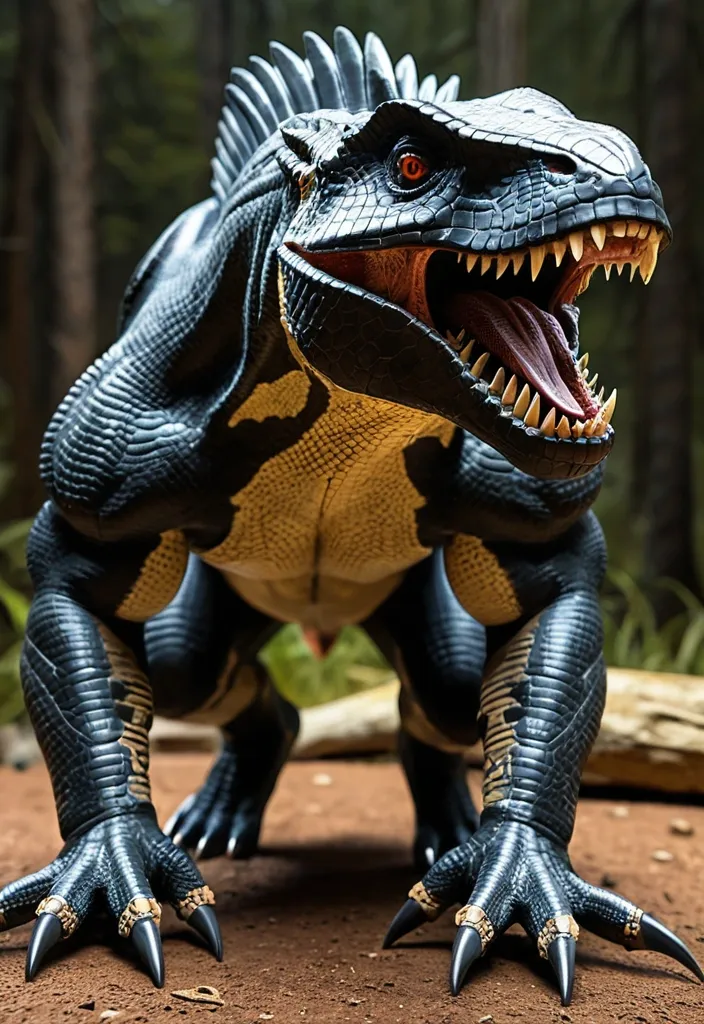
Physical Characteristics: Size & Build: Towering at around 15 feet tall and 40 feet long , Venenosus Rex exhibits a robust , muscular build with bulky , reduced hind legs adapted for powerful knuckle-walking quadrupedal locomotion , inherited from its Ape DNA. Its stance is low and intimidating , allowing swift bursts of speed and stability. Head: The head is a terrifying blend of Tyrannosaurus rex , Giganotosaurus , and Triceratops shapes—a broad , armored skull with a reinforced bony frill and horn-like protrusions from Triceratops , providing natural defense. Its jaw can open up to 90 degrees , snake-like , capable of delivering crushing bites able to shatter bulletproof glass. Skin & Camouflage: Covered in thick , overlapping Scelidosaurus-like osteoderm armor plates along the back and flanks , providing excellent protection against attacks. The skin contains chromatophore cells from cuttlefish DNA , allowing Venenosus Rex to dynamically change skin color , texture , and pattern for camouflage or intimidation. Arms & Claws: Long , powerful arms inspired by Saurophaganax and Ape DNA end in razor-sharp , hooked claws capable of slashing through armored prey and wielding tools for complex hunting strategies. Teeth & Fangs: Teeth are a deadly combination from the Inland Taipan’s retractable fangs , Komodo Dragon’s serrated teeth , and Northern short-tailed shrew’s sharp incisors , allowing it to pierce armor and inject highly toxic saliva into prey. Eyes & Senses: Equipped with specialized cranial cavities housing infrared vision , enabling night hunting and detection of body heat signatures. Its olfactory and auditory senses are exceptionally refined due to Utahraptor and Komodo Dragon ancestry. Unique Abilities: Extreme Environmental Resistance: Thanks to Tardigrade , Opossum , and Mongoose DNA , Venenosus Rex can survive extreme temperatures , radiation , dehydration , starvation , and bacterial infections. Its organs are shielded by trehalose gel , and its DNA is protected by specialized proteins against radiation damage. It can slow its metabolism down to 0.01% of normal , entering a near-hibernative state during harsh conditions. Toxic Saliva & Venom: Its saliva contains potent neurotoxins and anticoagulants , ensuring even minor bites are deadly over time. Combined with its retractable fangs , it can efficiently incapacitate prey or rivals. Camouflage & Stealth: Dynamic skin color and texture changes allow it to blend seamlessly into diverse environments or mimic threatening patterns to intimidate. Intelligence & Pack Hunting: Enhanced Utahraptor DNA grants high cognitive abilities , including planning , problem-solving , and social pack hunting tactics , making it a highly strategic predator. Tool Use: The combination of long , dexterous arms and ape DNA allows it to manipulate objects , set traps , or use environmental tools during hunts. Wide Jaw Opening: The ability to open its jaw at a 90-degree angle allows for impressive bite range and prey handling , intimidating foes with sudden wide gapes. ,
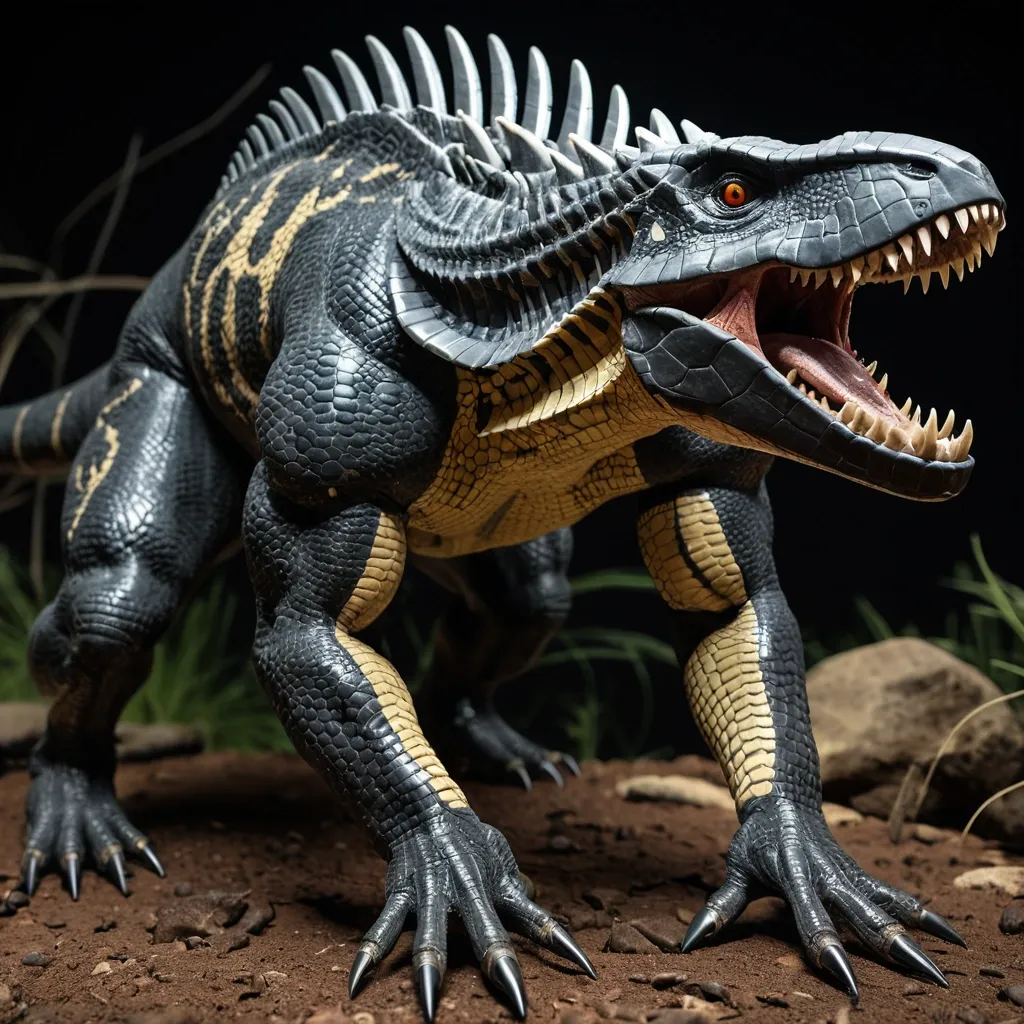
Physical Characteristics: Size & Build: Towering at around 15 feet tall and 40 feet long , Venenosus Rex exhibits a robust , muscular build with bulky , reduced hind legs adapted for powerful knuckle-walking quadrupedal locomotion , inherited from its Ape DNA. Its stance is low and intimidating , allowing swift bursts of speed and stability. Head: The head is a terrifying blend of Tyrannosaurus rex , Giganotosaurus , and Triceratops shapes—a broad , armored skull with a reinforced bony frill and horn-like protrusions from Triceratops , providing natural defense. Its jaw can open up to 90 degrees , snake-like , capable of delivering crushing bites able to shatter bulletproof glass. Skin & Camouflage: Covered in thick , overlapping Scelidosaurus-like osteoderm armor plates along the back and flanks , providing excellent protection against attacks. The skin contains chromatophore cells from cuttlefish DNA , allowing Venenosus Rex to dynamically change skin color , texture , and pattern for camouflage or intimidation. Arms & Claws: Long , powerful arms inspired by Saurophaganax and Ape DNA end in razor-sharp , hooked claws capable of slashing through armored prey and wielding tools for complex hunting strategies. Teeth & Fangs: Teeth are a deadly combination from the Inland Taipan’s retractable fangs , Komodo Dragon’s serrated teeth , and Northern short-tailed shrew’s sharp incisors , allowing it to pierce armor and inject highly toxic saliva into prey. Eyes & Senses: Equipped with specialized cranial cavities housing infrared vision , enabling night hunting and detection of body heat signatures. Its olfactory and auditory senses are exceptionally refined due to Utahraptor and Komodo Dragon ancestry. Unique Abilities: Extreme Environmental Resistance: Thanks to Tardigrade , Opossum , and Mongoose DNA , Venenosus Rex can survive extreme temperatures , radiation , dehydration , starvation , and bacterial infections. Its organs are shielded by trehalose gel , and its DNA is protected by specialized proteins against radiation damage. It can slow its metabolism down to 0.01% of normal , entering a near-hibernative state during harsh conditions. Toxic Saliva & Venom: Its saliva contains potent neurotoxins and anticoagulants , ensuring even minor bites are deadly over time. Combined with its retractable fangs , it can efficiently incapacitate prey or rivals. Camouflage & Stealth: Dynamic skin color and texture changes allow it to blend seamlessly into diverse environments or mimic threatening patterns to intimidate. Intelligence & Pack Hunting: Enhanced Utahraptor DNA grants high cognitive abilities , including planning , problem-solving , and social pack hunting tactics , making it a highly strategic predator. Tool Use: The combination of long , dexterous arms and ape DNA allows it to manipulate objects , set traps , or use environmental tools during hunts. Wide Jaw Opening: The ability to open its jaw at a 90-degree angle allows for impressive bite range and prey handling , intimidating foes with sudden wide gapes. ,
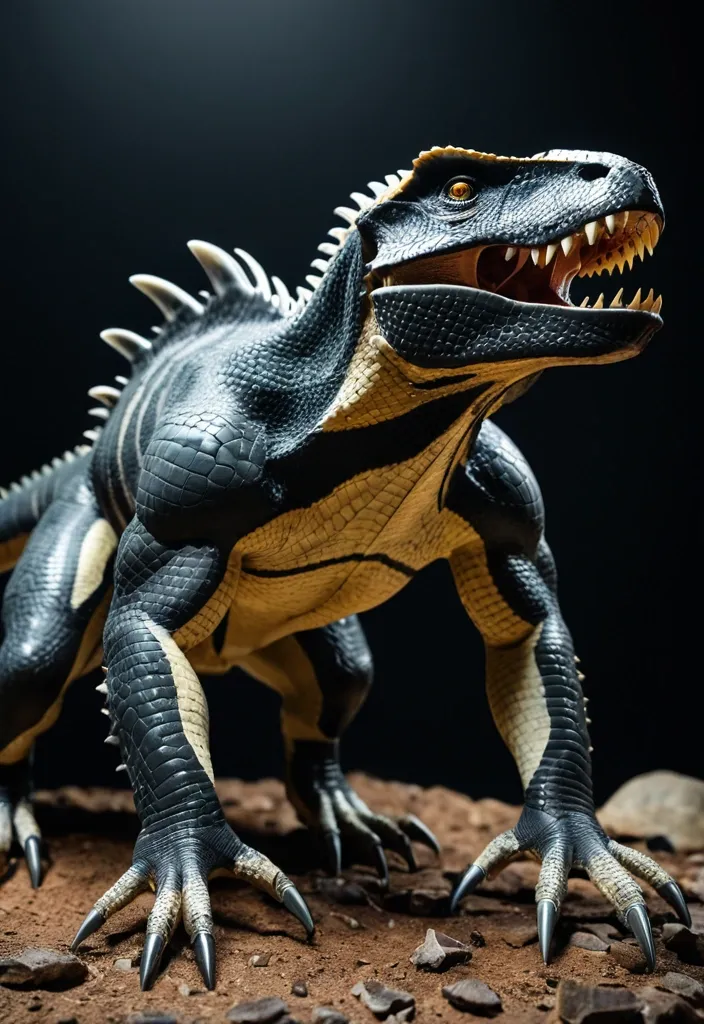
Physical Characteristics: Size & Build: Towering at around 15 feet tall and 40 feet long , Venenosus Rex exhibits a robust , muscular build with bulky , reduced hind legs adapted for powerful knuckle-walking quadrupedal locomotion , inherited from its Ape DNA. Its stance is low and intimidating , allowing swift bursts of speed and stability. Head: The head is a terrifying blend of Tyrannosaurus rex , Giganotosaurus , and Triceratops shapes—a broad , armored skull with a reinforced bony frill and horn-like protrusions from Triceratops , providing natural defense. Its jaw can open up to 90 degrees , snake-like , capable of delivering crushing bites able to shatter bulletproof glass. Skin & Camouflage: Covered in thick , overlapping Scelidosaurus-like osteoderm armor plates along the back and flanks , providing excellent protection against attacks. The skin contains chromatophore cells from cuttlefish DNA , allowing Venenosus Rex to dynamically change skin color , texture , and pattern for camouflage or intimidation. Arms & Claws: Long , powerful arms inspired by Saurophaganax and Ape DNA end in razor-sharp , hooked claws capable of slashing through armored prey and wielding tools for complex hunting strategies. Teeth & Fangs: Teeth are a deadly combination from the Inland Taipan’s retractable fangs , Komodo Dragon’s serrated teeth , and Northern short-tailed shrew’s sharp incisors , allowing it to pierce armor and inject highly toxic saliva into prey. Eyes & Senses: Equipped with specialized cranial cavities housing infrared vision , enabling night hunting and detection of body heat signatures. Its olfactory and auditory senses are exceptionally refined due to Utahraptor and Komodo Dragon ancestry. Unique Abilities: Extreme Environmental Resistance: Thanks to Tardigrade , Opossum , and Mongoose DNA , Venenosus Rex can survive extreme temperatures , radiation , dehydration , starvation , and bacterial infections. Its organs are shielded by trehalose gel , and its DNA is protected by specialized proteins against radiation damage. It can slow its metabolism down to 0.01% of normal , entering a near-hibernative state during harsh conditions. Toxic Saliva & Venom: Its saliva contains potent neurotoxins and anticoagulants , ensuring even minor bites are deadly over time. Combined with its retractable fangs , it can efficiently incapacitate prey or rivals. Camouflage & Stealth: Dynamic skin color and texture changes allow it to blend seamlessly into diverse environments or mimic threatening patterns to intimidate. Intelligence & Pack Hunting: Enhanced Utahraptor DNA grants high cognitive abilities , including planning , problem-solving , and social pack hunting tactics , making it a highly strategic predator. Tool Use: The combination of long , dexterous arms and ape DNA allows it to manipulate objects , set traps , or use environmental tools during hunts. Wide Jaw Opening: The ability to open its jaw at a 90-degree angle allows for impressive bite range and prey handling , intimidating foes with sudden wide gapes. ,
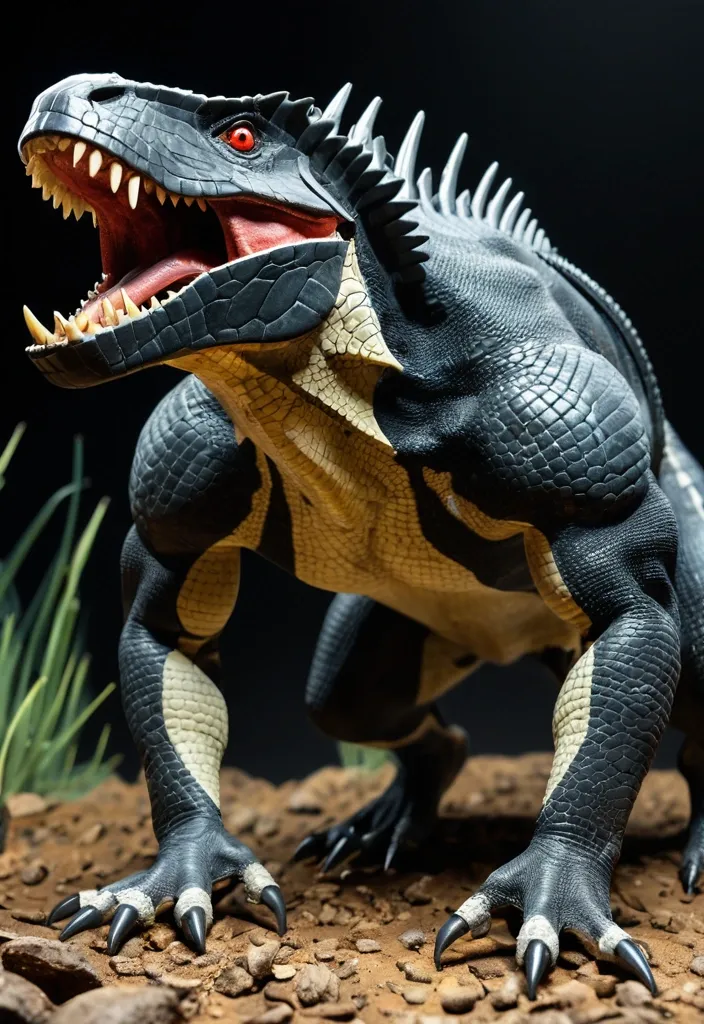
Physical Characteristics: Size & Build: Towering at around 15 feet tall and 40 feet long , Venenosus Rex exhibits a robust , muscular build with bulky , reduced hind legs adapted for powerful knuckle-walking quadrupedal locomotion , inherited from its Ape DNA. Its stance is low and intimidating , allowing swift bursts of speed and stability. Head: The head is a terrifying blend of Tyrannosaurus rex , Giganotosaurus , and Triceratops shapes—a broad , armored skull with a reinforced bony frill and horn-like protrusions from Triceratops , providing natural defense. Its jaw can open up to 90 degrees , snake-like , capable of delivering crushing bites able to shatter bulletproof glass. Skin & Camouflage: Covered in thick , overlapping Scelidosaurus-like osteoderm armor plates along the back and flanks , providing excellent protection against attacks. The skin contains chromatophore cells from cuttlefish DNA , allowing Venenosus Rex to dynamically change skin color , texture , and pattern for camouflage or intimidation. Arms & Claws: Long , powerful arms inspired by Saurophaganax and Ape DNA end in razor-sharp , hooked claws capable of slashing through armored prey and wielding tools for complex hunting strategies. Teeth & Fangs: Teeth are a deadly combination from the Inland Taipan’s retractable fangs , Komodo Dragon’s serrated teeth , and Northern short-tailed shrew’s sharp incisors , allowing it to pierce armor and inject highly toxic saliva into prey. Eyes & Senses: Equipped with specialized cranial cavities housing infrared vision , enabling night hunting and detection of body heat signatures. Its olfactory and auditory senses are exceptionally refined due to Utahraptor and Komodo Dragon ancestry. Unique Abilities: Extreme Environmental Resistance: Thanks to Tardigrade , Opossum , and Mongoose DNA , Venenosus Rex can survive extreme temperatures , radiation , dehydration , starvation , and bacterial infections. Its organs are shielded by trehalose gel , and its DNA is protected by specialized proteins against radiation damage. It can slow its metabolism down to 0.01% of normal , entering a near-hibernative state during harsh conditions. Toxic Saliva & Venom: Its saliva contains potent neurotoxins and anticoagulants , ensuring even minor bites are deadly over time. Combined with its retractable fangs , it can efficiently incapacitate prey or rivals. Camouflage & Stealth: Dynamic skin color and texture changes allow it to blend seamlessly into diverse environments or mimic threatening patterns to intimidate. Intelligence & Pack Hunting: Enhanced Utahraptor DNA grants high cognitive abilities , including planning , problem-solving , and social pack hunting tactics , making it a highly strategic predator. Tool Use: The combination of long , dexterous arms and ape DNA allows it to manipulate objects , set traps , or use environmental tools during hunts. Wide Jaw Opening: The ability to open its jaw at a 90-degree angle allows for impressive bite range and prey handling , intimidating foes with sudden wide gapes. ,
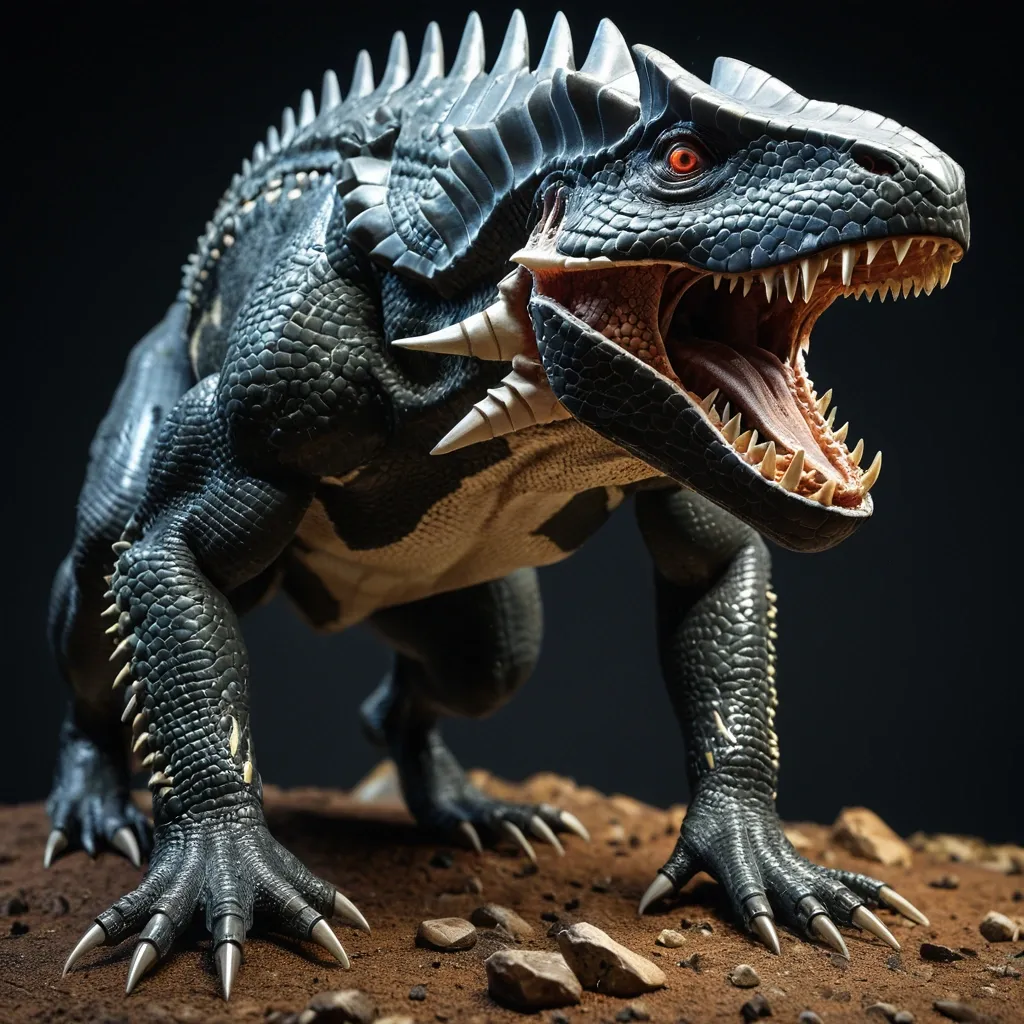
Physical Characteristics: Size & Build: Towering at around 15 feet tall and 40 feet long , Venenosus Rex exhibits a robust , muscular build with bulky , reduced hind legs adapted for powerful knuckle-walking quadrupedal locomotion , inherited from its Ape DNA. Its stance is low and intimidating , allowing swift bursts of speed and stability. Head: The head is a terrifying blend of Tyrannosaurus rex , Giganotosaurus , and Triceratops shapes—a broad , armored skull with a reinforced bony frill and horn-like protrusions from Triceratops , providing natural defense. Its jaw can open up to 90 degrees , snake-like , capable of delivering crushing bites able to shatter bulletproof glass. Skin & Camouflage: Covered in thick , overlapping Scelidosaurus-like osteoderm armor plates along the back and flanks , providing excellent protection against attacks. The skin contains chromatophore cells from cuttlefish DNA , allowing Venenosus Rex to dynamically change skin color , texture , and pattern for camouflage or intimidation. Arms & Claws: Long , powerful arms inspired by Saurophaganax and Ape DNA end in razor-sharp , hooked claws capable of slashing through armored prey and wielding tools for complex hunting strategies. Teeth & Fangs: Teeth are a deadly combination from the Inland Taipan’s retractable fangs , Komodo Dragon’s serrated teeth , and Northern short-tailed shrew’s sharp incisors , allowing it to pierce armor and inject highly toxic saliva into prey. Eyes & Senses: Equipped with specialized cranial cavities housing infrared vision , enabling night hunting and detection of body heat signatures. Its olfactory and auditory senses are exceptionally refined due to Utahraptor and Komodo Dragon ancestry. Unique Abilities: Extreme Environmental Resistance: Thanks to Tardigrade , Opossum , and Mongoose DNA , Venenosus Rex can survive extreme temperatures , radiation , dehydration , starvation , and bacterial infections. Its organs are shielded by trehalose gel , and its DNA is protected by specialized proteins against radiation damage. It can slow its metabolism down to 0.01% of normal , entering a near-hibernative state during harsh conditions. Toxic Saliva & Venom: Its saliva contains potent neurotoxins and anticoagulants , ensuring even minor bites are deadly over time. Combined with its retractable fangs , it can efficiently incapacitate prey or rivals. Camouflage & Stealth: Dynamic skin color and texture changes allow it to blend seamlessly into diverse environments or mimic threatening patterns to intimidate. Intelligence & Pack Hunting: Enhanced Utahraptor DNA grants high cognitive abilities , including planning , problem-solving , and social pack hunting tactics , making it a highly strategic predator. Tool Use: The combination of long , dexterous arms and ape DNA allows it to manipulate objects , set traps , or use environmental tools during hunts. Wide Jaw Opening: The ability to open its jaw at a 90-degree angle allows for impressive bite range and prey handling , intimidating foes with sudden wide gapes. ,
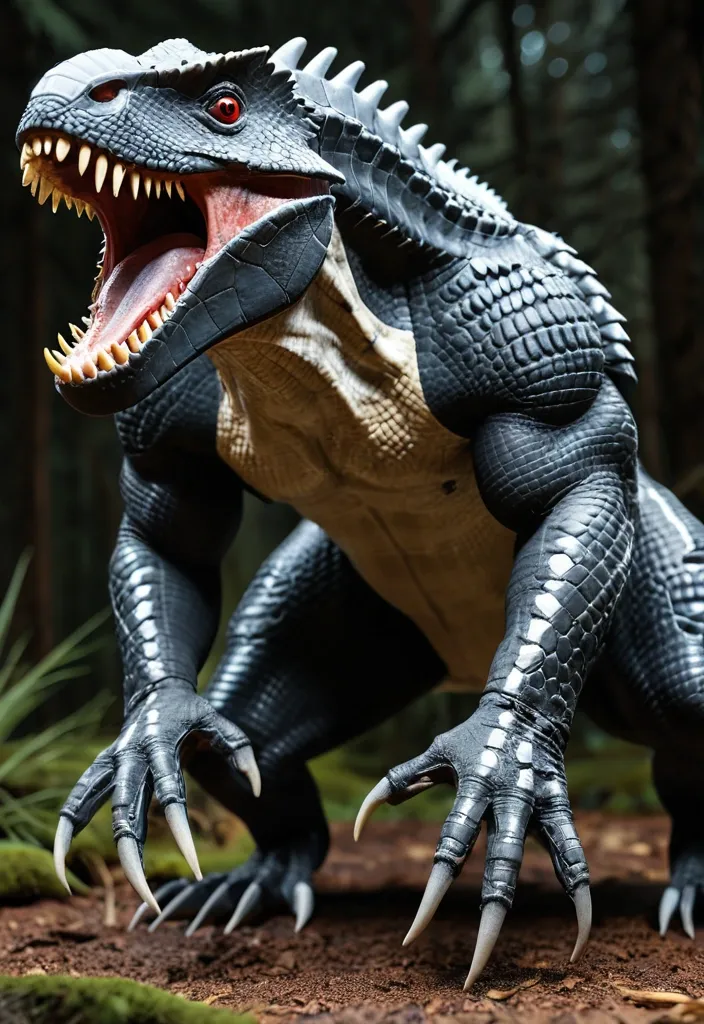
Physical Characteristics: Size & Build: Towering at around 15 feet tall and 40 feet long , Venenosus Rex exhibits a robust , muscular build with bulky , reduced hind legs adapted for powerful knuckle-walking quadrupedal locomotion , inherited from its Ape DNA. Its stance is low and intimidating , allowing swift bursts of speed and stability. Head: The head is a terrifying blend of Tyrannosaurus rex , Giganotosaurus , and Triceratops shapes—a broad , armored skull with a reinforced bony frill and horn-like protrusions from Triceratops , providing natural defense. Its jaw can open up to 90 degrees , snake-like , capable of delivering crushing bites able to shatter bulletproof glass. Skin & Camouflage: Covered in thick , overlapping Scelidosaurus-like osteoderm armor plates along the back and flanks , providing excellent protection against attacks. The skin contains chromatophore cells from cuttlefish DNA , allowing Venenosus Rex to dynamically change skin color , texture , and pattern for camouflage or intimidation. Arms & Claws: Long , powerful arms inspired by Saurophaganax and Ape DNA end in razor-sharp , hooked claws capable of slashing through armored prey and wielding tools for complex hunting strategies. Teeth & Fangs: Teeth are a deadly combination from the Inland Taipan’s retractable fangs , Komodo Dragon’s serrated teeth , and Northern short-tailed shrew’s sharp incisors , allowing it to pierce armor and inject highly toxic saliva into prey. Eyes & Senses: Equipped with specialized cranial cavities housing infrared vision , enabling night hunting and detection of body heat signatures. Its olfactory and auditory senses are exceptionally refined due to Utahraptor and Komodo Dragon ancestry. Unique Abilities: Extreme Environmental Resistance: Thanks to Tardigrade , Opossum , and Mongoose DNA , Venenosus Rex can survive extreme temperatures , radiation , dehydration , starvation , and bacterial infections. Its organs are shielded by trehalose gel , and its DNA is protected by specialized proteins against radiation damage. It can slow its metabolism down to 0.01% of normal , entering a near-hibernative state during harsh conditions. Toxic Saliva & Venom: Its saliva contains potent neurotoxins and anticoagulants , ensuring even minor bites are deadly over time. Combined with its retractable fangs , it can efficiently incapacitate prey or rivals. Camouflage & Stealth: Dynamic skin color and texture changes allow it to blend seamlessly into diverse environments or mimic threatening patterns to intimidate. Intelligence & Pack Hunting: Enhanced Utahraptor DNA grants high cognitive abilities , including planning , problem-solving , and social pack hunting tactics , making it a highly strategic predator. Tool Use: The combination of long , dexterous arms and ape DNA allows it to manipulate objects , set traps , or use environmental tools during hunts. Wide Jaw Opening: The ability to open its jaw at a 90-degree angle allows for impressive bite range and prey handling , intimidating foes with sudden wide gapes. ,
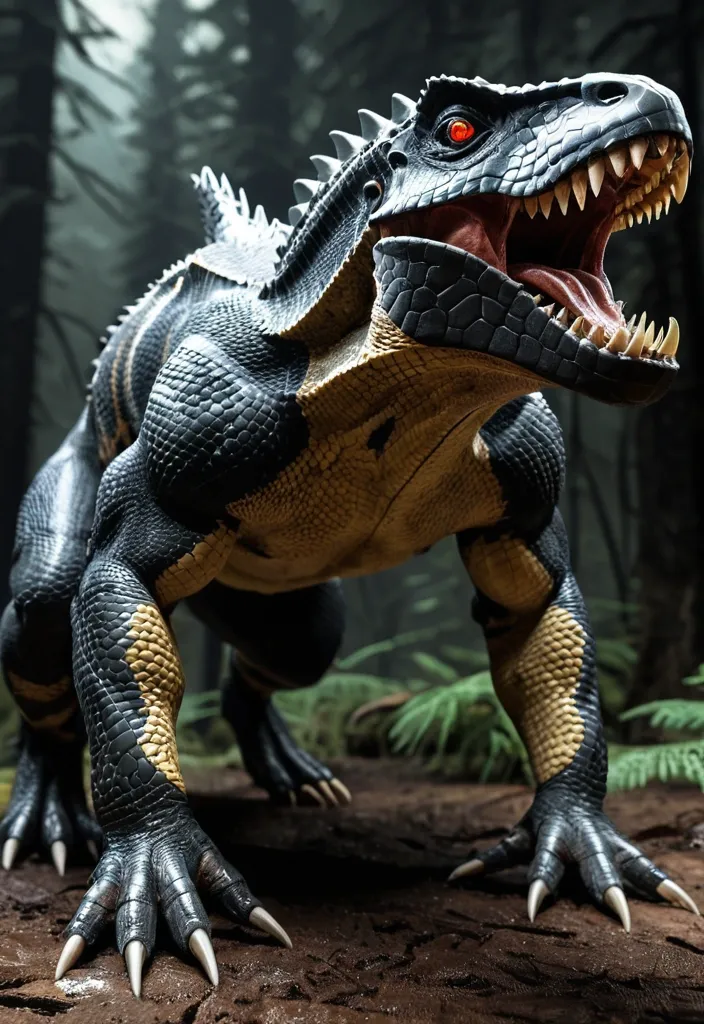
Physical Characteristics: Size & Build: Towering at around 15 feet tall and 40 feet long , Venenosus Rex exhibits a robust , muscular build with bulky , reduced hind legs adapted for powerful knuckle-walking quadrupedal locomotion , inherited from its Ape DNA. Its stance is low and intimidating , allowing swift bursts of speed and stability. Head: The head is a terrifying blend of Tyrannosaurus rex , Giganotosaurus , and Triceratops shapes—a broad , armored skull with a reinforced bony frill and horn-like protrusions from Triceratops , providing natural defense. Its jaw can open up to 90 degrees , snake-like , capable of delivering crushing bites able to shatter bulletproof glass. Skin & Camouflage: Covered in thick , overlapping Scelidosaurus-like osteoderm armor plates along the back and flanks , providing excellent protection against attacks. The skin contains chromatophore cells from cuttlefish DNA , allowing Venenosus Rex to dynamically change skin color , texture , and pattern for camouflage or intimidation. Arms & Claws: Long , powerful arms inspired by Saurophaganax and Ape DNA end in razor-sharp , hooked claws capable of slashing through armored prey and wielding tools for complex hunting strategies. Teeth & Fangs: Teeth are a deadly combination from the Inland Taipan’s retractable fangs , Komodo Dragon’s serrated teeth , and Northern short-tailed shrew’s sharp incisors , allowing it to pierce armor and inject highly toxic saliva into prey. Eyes & Senses: Equipped with specialized cranial cavities housing infrared vision , enabling night hunting and detection of body heat signatures. Its olfactory and auditory senses are exceptionally refined due to Utahraptor and Komodo Dragon ancestry. Unique Abilities: Extreme Environmental Resistance: Thanks to Tardigrade , Opossum , and Mongoose DNA , Venenosus Rex can survive extreme temperatures , radiation , dehydration , starvation , and bacterial infections. Its organs are shielded by trehalose gel , and its DNA is protected by specialized proteins against radiation damage. It can slow its metabolism down to 0.01% of normal , entering a near-hibernative state during harsh conditions. Toxic Saliva & Venom: Its saliva contains potent neurotoxins and anticoagulants , ensuring even minor bites are deadly over time. Combined with its retractable fangs , it can efficiently incapacitate prey or rivals. Camouflage & Stealth: Dynamic skin color and texture changes allow it to blend seamlessly into diverse environments or mimic threatening patterns to intimidate. Intelligence & Pack Hunting: Enhanced Utahraptor DNA grants high cognitive abilities , including planning , problem-solving , and social pack hunting tactics , making it a highly strategic predator. Tool Use: The combination of long , dexterous arms and ape DNA allows it to manipulate objects , set traps , or use environmental tools during hunts. Wide Jaw Opening: The ability to open its jaw at a 90-degree angle allows for impressive bite range and prey handling , intimidating foes with sudden wide gapes. ,
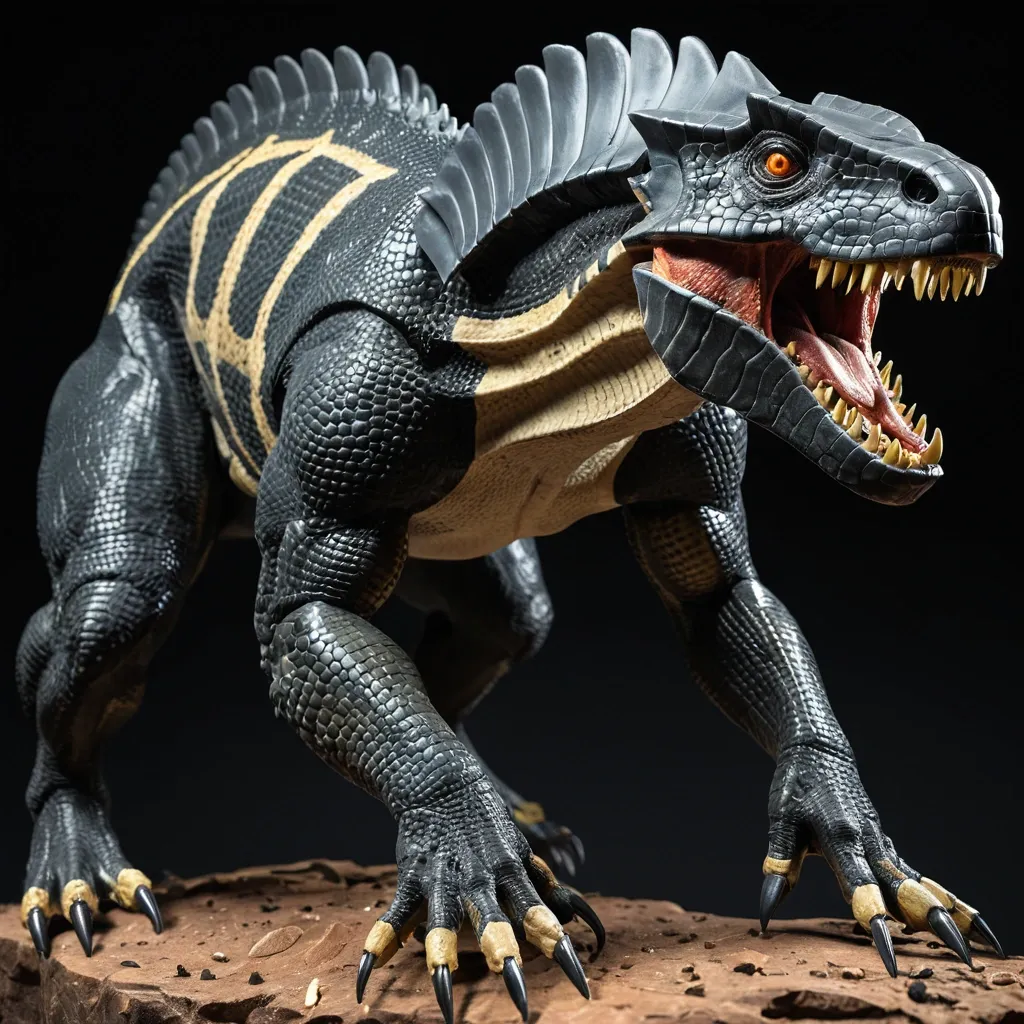
Physical Characteristics: Size & Build: Towering at around 15 feet tall and 40 feet long , Venenosus Rex exhibits a robust , muscular build with bulky , reduced hind legs adapted for powerful knuckle-walking quadrupedal locomotion , inherited from its Ape DNA. Its stance is low and intimidating , allowing swift bursts of speed and stability. Head: The head is a terrifying blend of Tyrannosaurus rex , Giganotosaurus , and Triceratops shapes—a broad , armored skull with a reinforced bony frill and horn-like protrusions from Triceratops , providing natural defense. Its jaw can open up to 90 degrees , snake-like , capable of delivering crushing bites able to shatter bulletproof glass. Skin & Camouflage: Covered in thick , overlapping Scelidosaurus-like osteoderm armor plates along the back and flanks , providing excellent protection against attacks. The skin contains chromatophore cells from cuttlefish DNA , allowing Venenosus Rex to dynamically change skin color , texture , and pattern for camouflage or intimidation. Arms & Claws: Long , powerful arms inspired by Saurophaganax and Ape DNA end in razor-sharp , hooked claws capable of slashing through armored prey and wielding tools for complex hunting strategies. Teeth & Fangs: Teeth are a deadly combination from the Inland Taipan’s retractable fangs , Komodo Dragon’s serrated teeth , and Northern short-tailed shrew’s sharp incisors , allowing it to pierce armor and inject highly toxic saliva into prey. Eyes & Senses: Equipped with specialized cranial cavities housing infrared vision , enabling night hunting and detection of body heat signatures. Its olfactory and auditory senses are exceptionally refined due to Utahraptor and Komodo Dragon ancestry. Unique Abilities: Extreme Environmental Resistance: Thanks to Tardigrade , Opossum , and Mongoose DNA , Venenosus Rex can survive extreme temperatures , radiation , dehydration , starvation , and bacterial infections. Its organs are shielded by trehalose gel , and its DNA is protected by specialized proteins against radiation damage. It can slow its metabolism down to 0.01% of normal , entering a near-hibernative state during harsh conditions. Toxic Saliva & Venom: Its saliva contains potent neurotoxins and anticoagulants , ensuring even minor bites are deadly over time. Combined with its retractable fangs , it can efficiently incapacitate prey or rivals. Camouflage & Stealth: Dynamic skin color and texture changes allow it to blend seamlessly into diverse environments or mimic threatening patterns to intimidate. Intelligence & Pack Hunting: Enhanced Utahraptor DNA grants high cognitive abilities , including planning , problem-solving , and social pack hunting tactics , making it a highly strategic predator. Tool Use: The combination of long , dexterous arms and ape DNA allows it to manipulate objects , set traps , or use environmental tools during hunts. Wide Jaw Opening: The ability to open its jaw at a 90-degree angle allows for impressive bite range and prey handling , intimidating foes with sudden wide gapes. ,

Very big Gorgeous housewife big breast , bbw muscular enormous bimbo powerlifteuse , abnormally massive female muscular bodybuilder , bbw , Géante dame , Jennifer Lawrence face , curvacious , gorgeous , wearing housewife satin open hostesse shirt sans manches , gros biceps énormes , flexing muscles , cuisses en évidence , flexing biceps , make up , pov boxing poster ,

Very big Gorgeous housewife big breast , bbw muscular enormous bimbo powerlifteuse , abnormally massive female muscular bodybuilder , bbw , Géante dame , Jennifer Lawrence face , curvacious , gorgeous , wearing housewife satin open wet shirt sans manches , gros biceps énormes , flexing muscles , cuisses en évidence , flexing biceps , make up , pov boxing poster ,

Very big Gorgeous housewife big breast , bbw muscular enormous bimbo powerlifteuse , abnormally massive female muscular bodybuilder , bbw , Géante dame , Jennifer Lawrence face , curvacious , gorgeous , wearing housewife tight shirt décolletée , gros biceps énormes , flexing muscles , cuisses en évidence , flexing biceps , make up , pov boxing poster ,

Monster High doll style , full-body , cinematic lighting , Digital Banshee character: - **Skin:** Porcelain white with glowing pink veins , - **Eyes:** Luminescent green with skull-shaped pupils (shifting to red/blue) , - **Horns:** Curved ram horns , gradient pink to black , glowing LED tips , - **Wings:** Translucent cicada wings with floating hexadecimal codes (#FFB6C1) , - **Tail:** Scorpion stinger + pink fur pom-pom , - **Outfit:** Black latex corset with neon-pink circuit patterns , layered glitch-print tulle skirt , 15cm spike-heeled boots with speakers , - **Accessories:** Holographic collar (mini portal inside) , clawed USB-fingerless gloves , - **Details:** Python-code scars on arms , hair shifting from platinum to acid pink , Background: Neon-lit cyberpunk cathedral with broken stained glass. Dynamic pose , laughing with glitch-effect soundwaves around mouth , Style: Tim Burton meets Tetsuya Nomura , hyper-detailed , 8k. ,

Monster High doll style , full-body , cinematic lighting , Digital Banshee character: - **Skin:** Porcelain white with glowing pink veins , - **Eyes:** Luminescent green with skull-shaped pupils (shifting to red/blue) , - **Horns:** Curved ram horns , gradient pink to black , glowing LED tips , - **Wings:** Translucent cicada wings with floating hexadecimal codes (#FFB6C1) , - **Tail:** Scorpion stinger + pink fur pom-pom , - **Outfit:** Black latex corset with neon-pink circuit patterns , layered glitch-print tulle skirt , 15cm spike-heeled boots with speakers , - **Accessories:** Holographic collar (mini portal inside) , clawed USB-fingerless gloves , - **Details:** Python-code scars on arms , hair shifting from platinum to acid pink , Background: Neon-lit cyberpunk cathedral with broken stained glass. Dynamic pose , laughing with glitch-effect soundwaves around mouth , Style: Tim Burton meets Tetsuya Nomura , hyper-detailed , 8k. ,

Very big Gorgeous housewife big breast , bbw muscular enormous bimbo powerlifteuse , abnormally massive female muscular bodybuilder , bbw , Géante dame , Jennifer Lawrence face , curvacious , gorgeous , wearing housewife sleep satin open transparent shirt sans manches , gros biceps énormes , flexing muscles , cuisses en évidence , flexing biceps , make up , pov boxing poster ,

A surreal landscape Melting from a female face partially engulfed in viscous , holding wine glass , dripping ice cream. The liquid twists into anguished faces and claw-like fingers reaching outward. The backdrop shows faint , out-of-focus city lights in deep shades , blending black , stark white , and rusty red hues. The composition is high contrast and minimalist , evoking a sinister , haunting atmosphere. ,

Very big Gorgeous female too big breast , bbw muscular enormous bimbo powerlifteuse , abnormally massive female muscular bodybuilder , bbw , Géante dame , Jennifer Lawrence face , curvacious , gorgeous , wearing sexiest sensual bleue night dress décolletée , gros biceps énormes , flexing muscles , cuisses en évidence , flexing biceps , make up , pov boxing poster ,

Very big Gorgeous female too big breast , bbw muscular enormous bimbo powerlifteuse , abnormally massive female muscular bodybuilder , bbw , Géante dame , Jennifer Lawrence face , curvacious , gorgeous , wearing sexiest sensual black sleep dress décolletée , gros biceps énormes , flexing muscles , cuisses en évidence , flexing biceps , make up , pov boxing poster ,

Very big Gorgeous female too big breast , bbw muscular enormous bimbo powerlifteuse , abnormally massive female muscular bodybuilder , bbw , Géante dame , Jennifer Lawrence face , curvacious , gorgeous , wearing sexiest sensual bleue night club dress décolletée , gros biceps énormes , flexing muscles , cuisses en évidence , flexing biceps , make up , pov boxing poster ,
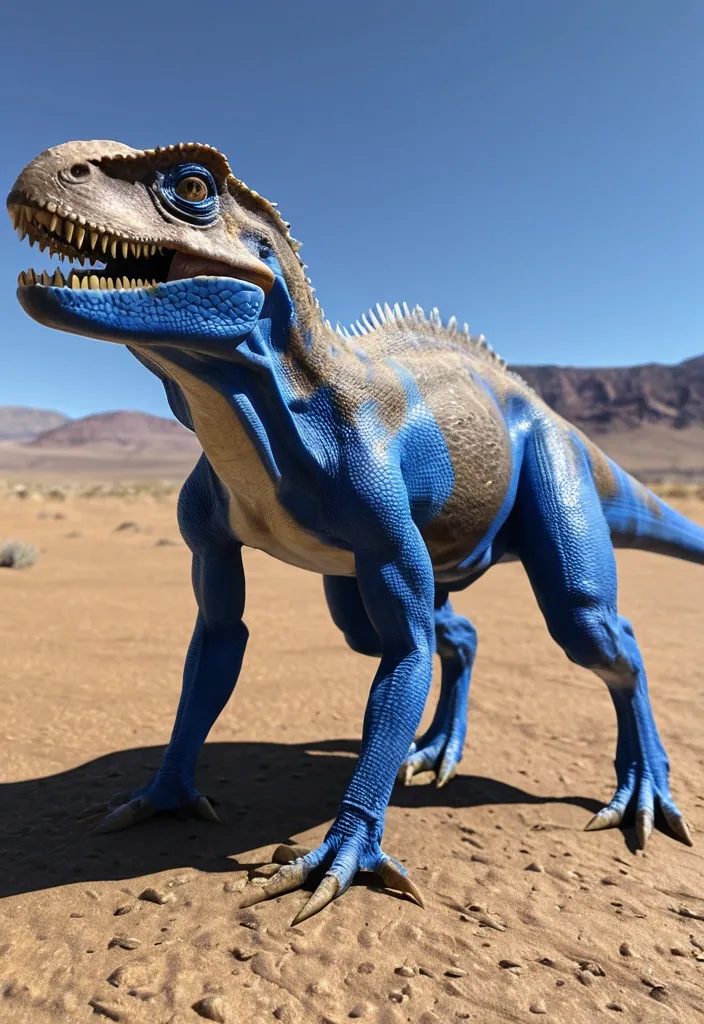
The hybrid was created by modifying the genome of a Tyrannosaurus rex , with the DNA of three other theropod species that were Utahraptor , Saurophaganax , and Giganotosaurus. Also the DNA of Quadrupes like Triceratops , Scelidosaurus , Gigantopithecus. DNA of modern animals such as Greater blue-ringed octopus , Inland Taipan , Northern Short-tailed Shrew , Komodo Dragon , Opossum , Mongoose , Whiptail Lizard , Cuttlefish , and Tardigrades. The genome of Tyrannosaurus rex , Utahraptor , Saurophaganax , and Giganotosaurus was used as the base genome for the hybrid. The shape of the headcrest is from the Triceratops. Utahraptor DNA was added for high levels of intelligence and the ability to make plans , decisions and pack hunting. Gigantopithecus DNA added for Knuckle-walking. Triceratops , and Scelidosaurus armor added a biological form of armor that absorbed most of the incoming attacks. Northern short-tailed shrew iron teeth , the Inland taipan's retractable fangs and the Komodo Dragon serrated teeth genome was used to form the teething of the hybrid. Saurophaganax and Gigantopithecus DNA added the presence of long strong arms with slashing hook claws and the use of tools. Cuttlefish genes were intended to help the hybrid withstand an accelerated growth , but it also added chromatophore cells in the skin so it could change the shape , color , and texture of its skin like a cuttlefish. Opossum , Mongoose and Tardigrades DNA was added for the hybrid to be more resistant to climate changes , harmful toxins or bacterial infections , while tardigrades also added survival of extreme conditions such as exposure to extreme temperatures , extreme pressures , air deprivation , radiation , dehydration , and starvation. Northern short-tailed shrew , the Inland Taipan , Greater blue-ringed octopus and the Komodo Dragon's DNA also added special cavities and glands in the skull that gave her infrared vision , and highly toxic saliva. Said DNA also gave her the ability to open her mandibles and jaws as wide as a snake , specifically at around 90 degrees.Lastly , DNA from a whiptail lizard was added for reproduction purposes. ,
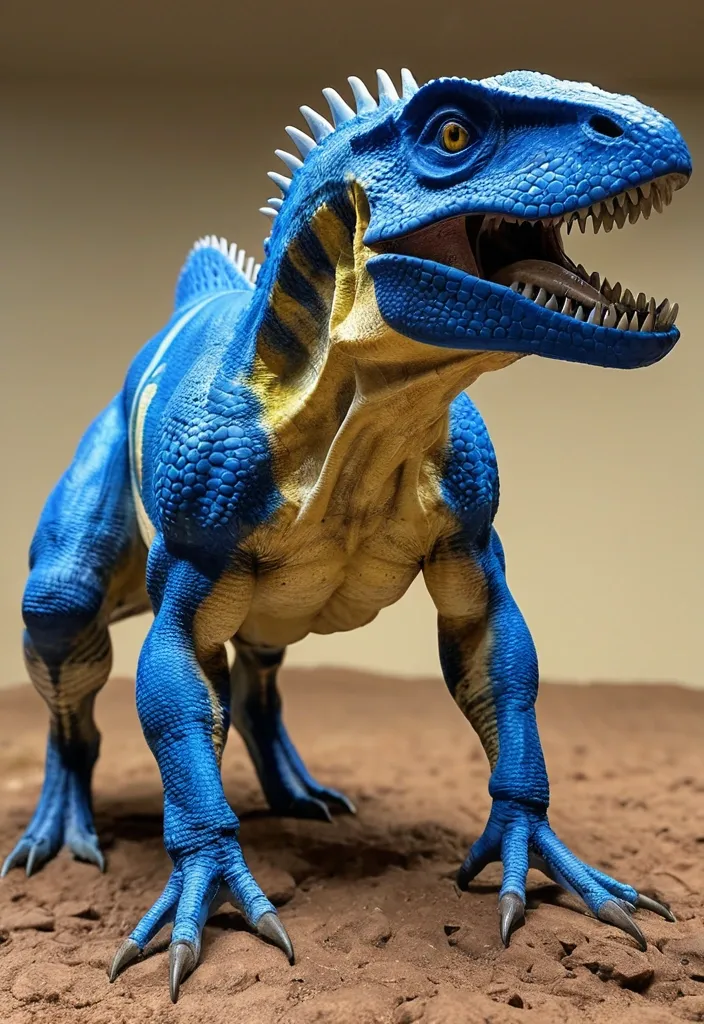
The hybrid was created by modifying the genome of a Tyrannosaurus rex , with the DNA of three other theropod species that were Utahraptor , Saurophaganax , and Giganotosaurus. Also the DNA of Quadrupes like Triceratops , Scelidosaurus , Gigantopithecus. DNA of modern animals such as Greater blue-ringed octopus , Inland Taipan , Northern Short-tailed Shrew , Komodo Dragon , Opossum , Mongoose , Whiptail Lizard , Cuttlefish , and Tardigrades. The genome of Tyrannosaurus rex , Utahraptor , Saurophaganax , and Giganotosaurus was used as the base genome for the hybrid. The shape of the headcrest is from the Triceratops. Utahraptor DNA was added for high levels of intelligence and the ability to make plans , decisions and pack hunting. Gigantopithecus DNA added for Knuckle-walking. Triceratops , and Scelidosaurus armor added a biological form of armor that absorbed most of the incoming attacks. Northern short-tailed shrew iron teeth , the Inland taipan's retractable fangs and the Komodo Dragon serrated teeth genome was used to form the teething of the hybrid. Saurophaganax and Gigantopithecus DNA added the presence of long strong arms with slashing hook claws and the use of tools. Cuttlefish genes were intended to help the hybrid withstand an accelerated growth , but it also added chromatophore cells in the skin so it could change the shape , color , and texture of its skin like a cuttlefish. Opossum , Mongoose and Tardigrades DNA was added for the hybrid to be more resistant to climate changes , harmful toxins or bacterial infections , while tardigrades also added survival of extreme conditions such as exposure to extreme temperatures , extreme pressures , air deprivation , radiation , dehydration , and starvation. Northern short-tailed shrew , the Inland Taipan , Greater blue-ringed octopus and the Komodo Dragon's DNA also added special cavities and glands in the skull that gave her infrared vision , and highly toxic saliva. Said DNA also gave her the ability to open her mandibles and jaws as wide as a snake , specifically at around 90 degrees.Lastly , DNA from a whiptail lizard was added for reproduction purposes. ,
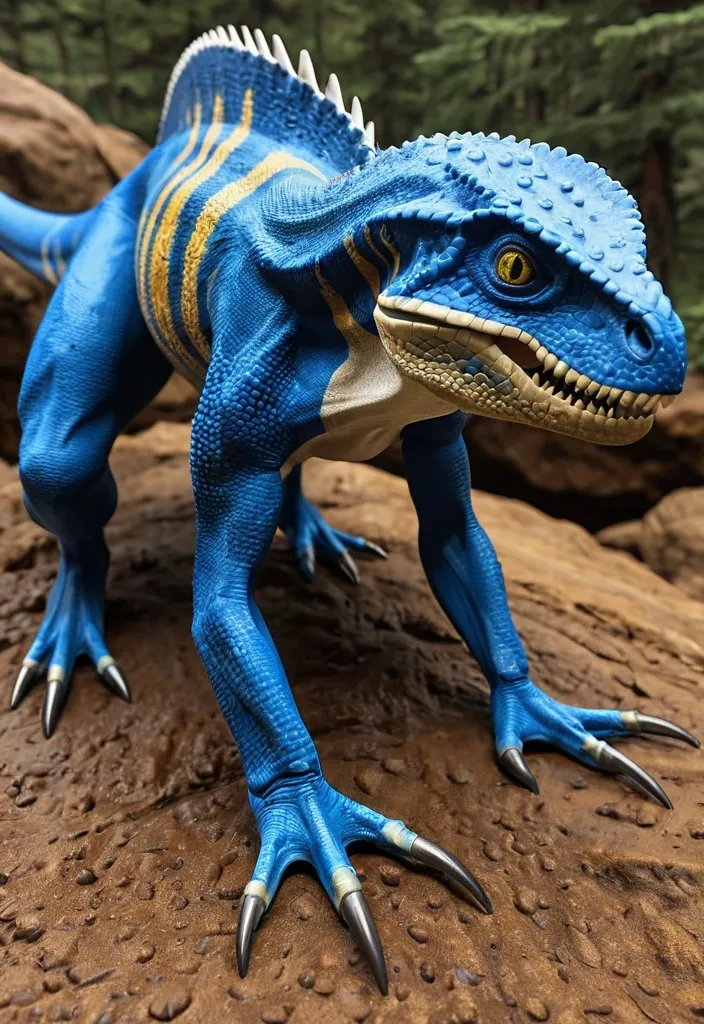
The hybrid was created by modifying the genome of a Tyrannosaurus rex , with the DNA of three other theropod species that were Utahraptor , Saurophaganax , and Giganotosaurus. Also the DNA of Quadrupes like Triceratops , Scelidosaurus , Gigantopithecus. DNA of modern animals such as Greater blue-ringed octopus , Inland Taipan , Northern Short-tailed Shrew , Komodo Dragon , Opossum , Mongoose , Whiptail Lizard , Cuttlefish , and Tardigrades. The genome of Tyrannosaurus rex , Utahraptor , Saurophaganax , and Giganotosaurus was used as the base genome for the hybrid. The shape of the headcrest is from the Triceratops. Utahraptor DNA was added for high levels of intelligence and the ability to make plans , decisions and pack hunting. Gigantopithecus DNA added for Knuckle-walking. Triceratops , and Scelidosaurus armor added a biological form of armor that absorbed most of the incoming attacks. Northern short-tailed shrew iron teeth , the Inland taipan's retractable fangs and the Komodo Dragon serrated teeth genome was used to form the teething of the hybrid. Saurophaganax and Gigantopithecus DNA added the presence of long strong arms with slashing hook claws and the use of tools. Cuttlefish genes were intended to help the hybrid withstand an accelerated growth , but it also added chromatophore cells in the skin so it could change the shape , color , and texture of its skin like a cuttlefish. Opossum , Mongoose and Tardigrades DNA was added for the hybrid to be more resistant to climate changes , harmful toxins or bacterial infections , while tardigrades also added survival of extreme conditions such as exposure to extreme temperatures , extreme pressures , air deprivation , radiation , dehydration , and starvation. Northern short-tailed shrew , the Inland Taipan , Greater blue-ringed octopus and the Komodo Dragon's DNA also added special cavities and glands in the skull that gave her infrared vision , and highly toxic saliva. Said DNA also gave her the ability to open her mandibles and jaws as wide as a snake , specifically at around 90 degrees.Lastly , DNA from a whiptail lizard was added for reproduction purposes. ,
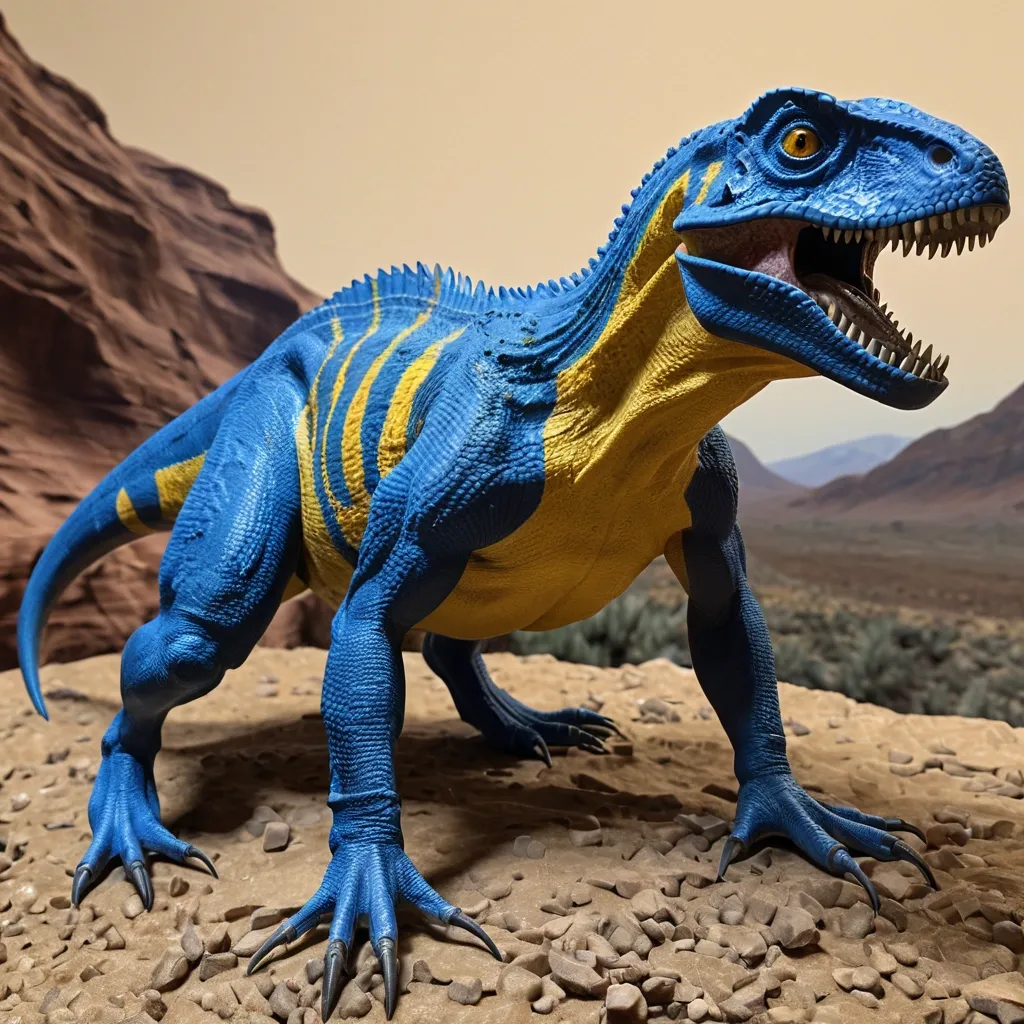
The hybrid was created by modifying the genome of a Tyrannosaurus rex , with the DNA of three other theropod species that were Utahraptor , Saurophaganax , and Giganotosaurus. Also the DNA of Quadrupes like Triceratops , Scelidosaurus , Gigantopithecus. DNA of modern animals such as Greater blue-ringed octopus , Inland Taipan , Northern Short-tailed Shrew , Komodo Dragon , Opossum , Mongoose , Whiptail Lizard , Cuttlefish , and Tardigrades. The genome of Tyrannosaurus rex , Utahraptor , Saurophaganax , and Giganotosaurus was used as the base genome for the hybrid. The shape of the headcrest is from the Triceratops. Utahraptor DNA was added for high levels of intelligence and the ability to make plans , decisions and pack hunting. Gigantopithecus DNA added for Knuckle-walking. Triceratops , and Scelidosaurus armor added a biological form of armor that absorbed most of the incoming attacks. Northern short-tailed shrew iron teeth , the Inland taipan's retractable fangs and the Komodo Dragon serrated teeth genome was used to form the teething of the hybrid. Saurophaganax and Gigantopithecus DNA added the presence of long strong arms with slashing hook claws and the use of tools. Cuttlefish genes were intended to help the hybrid withstand an accelerated growth , but it also added chromatophore cells in the skin so it could change the shape , color , and texture of its skin like a cuttlefish. Opossum , Mongoose and Tardigrades DNA was added for the hybrid to be more resistant to climate changes , harmful toxins or bacterial infections , while tardigrades also added survival of extreme conditions such as exposure to extreme temperatures , extreme pressures , air deprivation , radiation , dehydration , and starvation. Northern short-tailed shrew , the Inland Taipan , Greater blue-ringed octopus and the Komodo Dragon's DNA also added special cavities and glands in the skull that gave her infrared vision , and highly toxic saliva. Said DNA also gave her the ability to open her mandibles and jaws as wide as a snake , specifically at around 90 degrees.Lastly , DNA from a whiptail lizard was added for reproduction purposes. ,